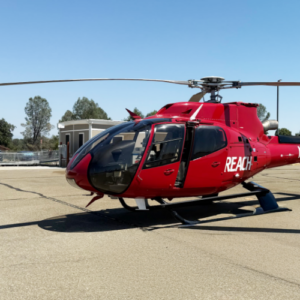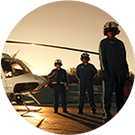When Time is a Factor
Imagine you’re a rancher in South Dakota or another state where hospitals are often a great distance from small towns or large ranches. You are working the back 30 acres of your land. The day is drawing to a close and it has been a long and hot one. You pause to catch your breath, but something feels wrong—an uncomfortable pressure begins to build in your chest. You try to shake it off, but the pain intensifies and your arm begins to go numb. You’re miles from the nearest town, and the dirt road to your property is rough and winding.
When you’re late for dinner your spouse goes out to find you and sees you slumped over the wheel of your 4×4. They call 911. The dispatcher listens carefully, asking questions to assess the severity of the situation. Based on your symptoms and location, they determine that ground transport won’t be fast enough. They initiate a call to the nearest air ambulance dispatch center, which immediately begins coordinating a response. Within minutes, a helicopter is airborne, guided by GPS coordinates and local emergency services. It lands in your field and the crew rush to your side. They find you are having an acute myocardial infarction, a heart attack, and immediately begin lifesaving treatments before the helicopter is even off the ground, rushing you 100 miles to the nearest cardiac center specialty hospital.
A Homesteading Accident
Now picture a homesteading family deep in the Nevada backcountry. Their child, adventurous and fearless, climbs a tall pine tree behind the family cabin. A misstep sends them tumbling to the ground. They lie unconscious, their breathing shallow.
The parents call 911, and the dispatcher sends the local sheriff who immediately recognizes the urgency. The nearest hospital is over an hour away by winding mountain roads. The sheriff directs dispatch to contact the regional medical helicopter, and an air ambulance is dispatched. The crew—trained in pediatric trauma—lands nearby and quickly assess the child. Suspecting a spinal cord injury, the crew gently transfers the unconscious child to their gurney and taking the child and a parent, fly 80 miles to the closest trauma center.
What Is an Air Ambulance?
Air ambulances are specially equipped aircraft—typically helicopters or fixed-wing planes—designed to transport critically ill or injured patients. These flying ICUs are staffed with highly trained medical personnel and carry advanced life-support equipment.
They are used mainly in two ways:
Scene Response
When someone is injured or falls ill in rural communities with limited access to healthcare or inaccessible location, air ambulances can be dispatched directly to the scene. This is common in rural areas, mountainous terrain, or during natural disasters. Over 40-million Americans live farther than an hour from a trauma center. Dispatchers and ground crews assess the urgency and location, and if ground transport is too slow or impractical, they call in air support.
Interfacility Transfers
Air ambulances also move patients between hospitals—especially when specialized care is needed. For example, a patient in a rural community hospital with limited healthcare services might be flown to a trauma center, burn unit, or cardiac facility. These transfers are coordinated between medical teams and often involve detailed planning to ensure continuity of care.
How Air Ambulances Are Called
The process begins with a 911 call or a hospital request. Emergency dispatchers or medical professionals assess the situation using triage. If the patient’s condition is critical and time-sensitive, ground crews cannot perform needed interventions, or the location is remote or difficult to reach, they contact an air ambulance provider.
Dispatch centers operate 24/7 and determine:
- Availability of aircraft and crew
- Weather conditions and flight safety
- Nearest appropriate medical facility
- Landing zone accessibility
Once cleared, the aircraft is launched, often with coordination from local EMS, Police or fire departments to secure a safe landing area.
Being Prepared in Rural Communities with Air Ambulance Care
Whether it’s a rancher in distress or an injured child, air ambulances bridge the gap between remote locations and rural communities with limited healthcare access and lifesaving care when time is of the essence. It’s important, especially if you live in an area far from hospitals, specialty hospitals or a trauma center, to know what to expect if an air ambulance is called.
It’s also important to be aware of the potential costs of an air ambulance transport and how much of those costs your insurance would pass on to your family. While every illness or accident can’t be prevented, a bill for air ambulance care could be.
AirMedCare Network (AMCN) strives to remove financial worry from air ambulance care. Covering over 2.9 million square miles of the United States, they have the largest network of air ambulance providers offering membership in the country. This can ensure that, only when transported by one of AMCN’s network providers, your family will experience no bill for your air ambulance care when you are a member.
There are many benefits to living in remote parts of the United States. Unfortunately, rural healthcare is not one of them. We want to bridge the gap in emergency healthcare access, and we want you not to have to worry about the cost. Learn more about our providers’ services in Rural America and our household membership starting at $99 a year.
Key Points Summary
- Dispatch centers coordinate air ambulance operations 24/7, assessing aircraft, crew, weather, safety, and landing zone accessibility before launch and are called for by qualified ground personnel.
- Air ambulances connect rural communities with limited healthcare access to lifesaving medical care, providing critical transport for patients far from hospitals or trauma centers.
- Understanding air ambulance costs and your insurance coverage is essential to avoid large medical bills for emergency transport.
- Living in rural communities has many advantages, but limited access to healthcare is a significant challenge that air ambulance services aim to address.
- AirMedCare Network offers membership that protects families from air ambulance bills only when transported by their network providers.
- AirMedCare Network household memberships start at $99 per year, offering financial peace of mind for rural Americans; more details are available on their website.

Tips for Staying Healthy on a Cruise
Cruising blends adventure with relaxation while exploring the world. But with so many fellow travelers on board in close quarters, endless temptations at the buffet

Global Medical Response to Open First Dedicated Air Medical Base on Oahu
New 24/7 critical-care helicopter, arriving in the fall, will ease rising EMS demand HONOLULU, Hawaii (July 22, 2025) — When rush-hour traffic brings Northshore and

Winterize your Health—How to ensure better health when the temperatures drop.
As the last leaves of Autumn fall and a winter chill begins to set in across the country, you may be taking steps to winterize




